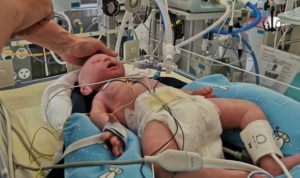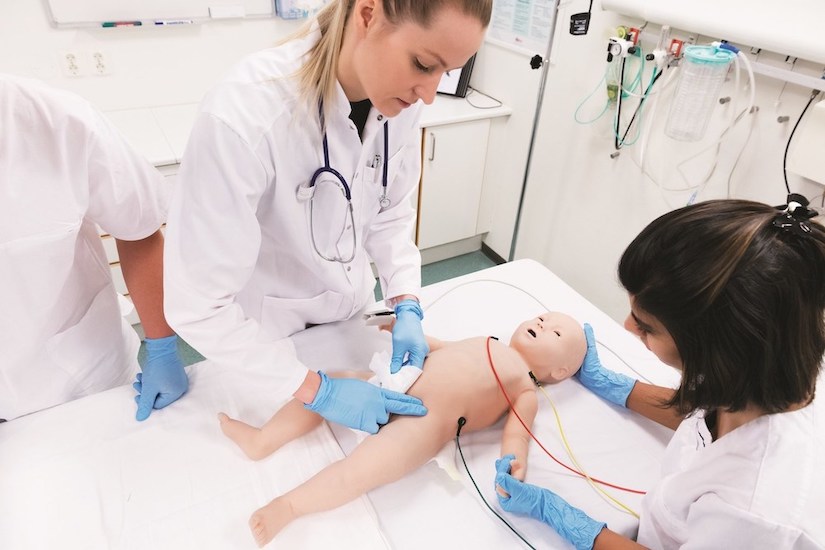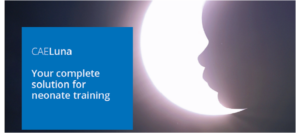Infant Manikin
An Infant Manikin is a life-like patient simulator that represents the body of a newborn patient. These products are known to offer effective infant cardiopulmonary resuscitation (CPR) training without compromising realism or quality. Furthermore, the convenient packaging of these manikins makes hands-on practice affordable for every learner. Note that there are a wide range of infant-based educational manikins available, ranging from more basic products geared towards educating high school students to more advanced simulators used to train emergency and pediatric medical teams.
These types of infant simulators and models can offer real-life experiences that address a number of healthcare circumstances including: Shaken Baby Syndrome, prenatal education, infant safety, substance abuse education, child care skills, CPR and more. Each hands-on learning module typically comes with everything a learner would need, from powerful, hands-on activities to complete curriculum and supplies.
With such a life-like infant appearance, and by offering sophisticated performance modules, these healthcare simulation products have a sensible and practical physiology for the purpose of training on infant care. The technology provides learners with the ability to focus on a broad range of pediatric skills pertaining to infants in order to gain exposure and practical experience of life-threatening pediatric problems.
Sponsored Content:
Research shows that healthcare learners’ and providers’ skill retention declines as soon as three months after completing a training module. Therefore, most healthcare workers do not get the experience they need to maintain skills outside of infrequent training intervals. Having access to and infant manikin revolutionizes the way training can take place, leading to an easily accessible and wireless training solution.
There are several infant simulators available on the market, such as those from CAE Healthcare, Gaumard and Laerdal Medical — some of which we share about below.
CAE Luna
CAE Healthcare’s first tetherless and completely wireless infant simulator, CAE Luna, offers a complete range of options for essential training in the care and medical treatment of a neonate in crisis. CAE Luna is remarkably lightweight and realistically represents a baby from birth to 28 days after delivery. Built on a scalable platform to meet critical healthcare education objectives and compliance requirements in newborn nursing, the Neonatal Resuscitation Program (NRP), and Pediatric Advanced Life Support (PALS), CAE Luna enables learners to practice and gain proficiency in newborn assessment, neonatal resuscitation, advanced life support and more.
Sponsored Content:
Combined with CAE Maestro’s user-friendly software interface and the exceptional blend of durability, reliability, and quality for which CAE is known, this neonatal simulator is everything you’ve been waiting for in infant patient simulation training.
Click Here to Connect to Leading Infant Manikin Vendors Today!
Baby Anne from Laerdal
One Infant Manikin on the market is the Baby Anne CPR simulator created by Laerdal. Much like the product’s adult counterpart, the Anne Simulator, the Baby Anne is designed to represent the body of an infant female. This highly realistic infant female simulator helps learners to understand the different aspects of modern nursing education and combine than with clinical infant care practices. Baby Anne is a lower fidelity manikin than Laerdal’s SimBaby, their premiere infant simulator.
This low-cost, lifelike infant CPR trainer is the perfect supplement to the Resusci Baby, which was Laerdal’s infant simulator manikin focused specifically on resuscitation quality improvement (RQI). While resuscitation is vital across infant healthcare, there are numerous other tasks, procedures and practices which medical professionals must thoroughly understand to be able to treat infants successfully.
Advancing past just resuscitation protocols, the Baby Anne product has introduced improved airway management system, allowing the model’s airway to close when the neck is hyperextended. The product is also educationally effective by offering all the essential features necessary for learning infant CPR.
According to Laerdal, Baby Anne is practical because the manikin itself is inexpensive and easy to maintain. The company also stresses that this product offers realistic chest compressions and chest rise allow students to learn proper techniques, durable construction leading to unequalled long-term use and that the Baby Anne simulator comes in a logistically convenient lightweight and portable four-pack weighing under 12.1 lb. This makes Baby Anne easy to transport.
Baby Anne also now comes with customized complexions and modernized clothing to enhance the overall realness simulated through the experience. The product is easy to maintain and inexpensive as well, affordability being a factor that led the simulator to becoming a more readily used form of hands-on practice.
Other features which has helped the Baby Anne infant model gain popularity across the medical training and education field are the oral and nasal passages, which allow realistic nose pinch required for mouth-to-nose ventilation. The product has a natural obstruction of the airway built-in to allow learners to become educated on the important technique of opening the airway.
To aide in the learning and education process, this manikin comes equipped with lifelike chest compliance. This means learners can experience the proper technique required for chest compressions on infants. A foreign-body airway obstruction is another included feature that allows for the release of a foreign-body obstruction to be practiced through back blows and chest-thrust techniques
Lastly, what really separates the Baby Anne simulator from other infant simulators on the market is that the product has a head tilt/chin lift and jaw thrust which allows learners to practice correctly all maneuvers necessary when resuscitating a real patient. Along with having removable and reusable faces for convenient and affordable maintenance, Baby Anne comes with economical disposable airways for quick and easy clean-up.
Real-World Use of Patient Simulators
Today, a well-known organization which utilizes infant manikins is the American Red Cross. Listed on the organization’s website under “training and certification” tools, these manikins come in a variety of skin tones, sets of multiple manikins and with or without CPR monitors.
For example, the American Red Cross’s “Medium Skin Infant Manikin with CPR Monitor,” is a Prestan Professional Infant CPR-AED Training Manikin with a medium complexion. This product comes with 10 infant face-shield and lung-bags, a CPR monitor, an instruction sheet and a red nylon carrying case featuring the Red Cross logo.
At approximately four times the cost, educators and trainees can look into purchasing a set of four of these manikins. The “Medium Skin Infant Manikins 4-Pack (with CPR monitor)” includes 50 infant face-shield/lung-bags, CPR monitors, an instruction sheet and a convenient red nylon carrying case which fits all four. Alternatively, the “Medium Skin Infant Manikin without CPR Monitor” still comes with the realistic Prestan Professional Infant Manikin, and offers optimal training simulation for CPR education, just without the CPR monitor.
Another real-world example of this technology comes from the Johns Hopkins All Children’s Hospital Center for Medical Simulation and Innovative Education. Here, Physicians, Nurses, Therapists and support team members are dedicated to providing safe,-advanced and well-trained care. This has led them to educating and training health care professionals and families alike in real-life, high-risk situations.
Simulation training at Johns Hopkins All Children’s Hospital puts the learner (which is oftentimes a parent) in real-life clinical scenarios overseen by an expert team of simulation specialists. Each training experience includes real-life scenarios, hybrid simulation and a debriefing. The goal of these training sessions is to provide learners with feedback, evaluation and the opportunity to reflect on the training pertaining to the care of an infant undergoing a medical emergency.
Overall, many people benefit from real-world training in a simulation center. The people benefiting the most tend to include hospital staff, parents and caregivers, hospital systems and research organizations. Healthcare simulation via manikins, including infant manikins, has helped the world of healthcare and technology to discover solutions and close the gaps between innovation, while adopting new practices and equipment.
Infant Simulator Latest News

Neonatal Lung Simulator LuSi from neosim Creates Realistic Pediatric Ventilator Training

Baby Lung Simulator LuSi Responds to Respiratory Therapy

CAE Luna Infant Simulator – Exclusive IMSH 2019 Video Demo & Bonus Dr. Patel Healthcare Academy Interview

Introducing the New Tetherless SimNewB Simulator From Laerdal

LifeCast Body Unveils Hyper Realistic Infant Trainer

Medical-X Continues Innovative Manikin Development with Updates to Adam-X & NENA Sim | IMSH 2017 Video Interview
Sponsored Content:
















